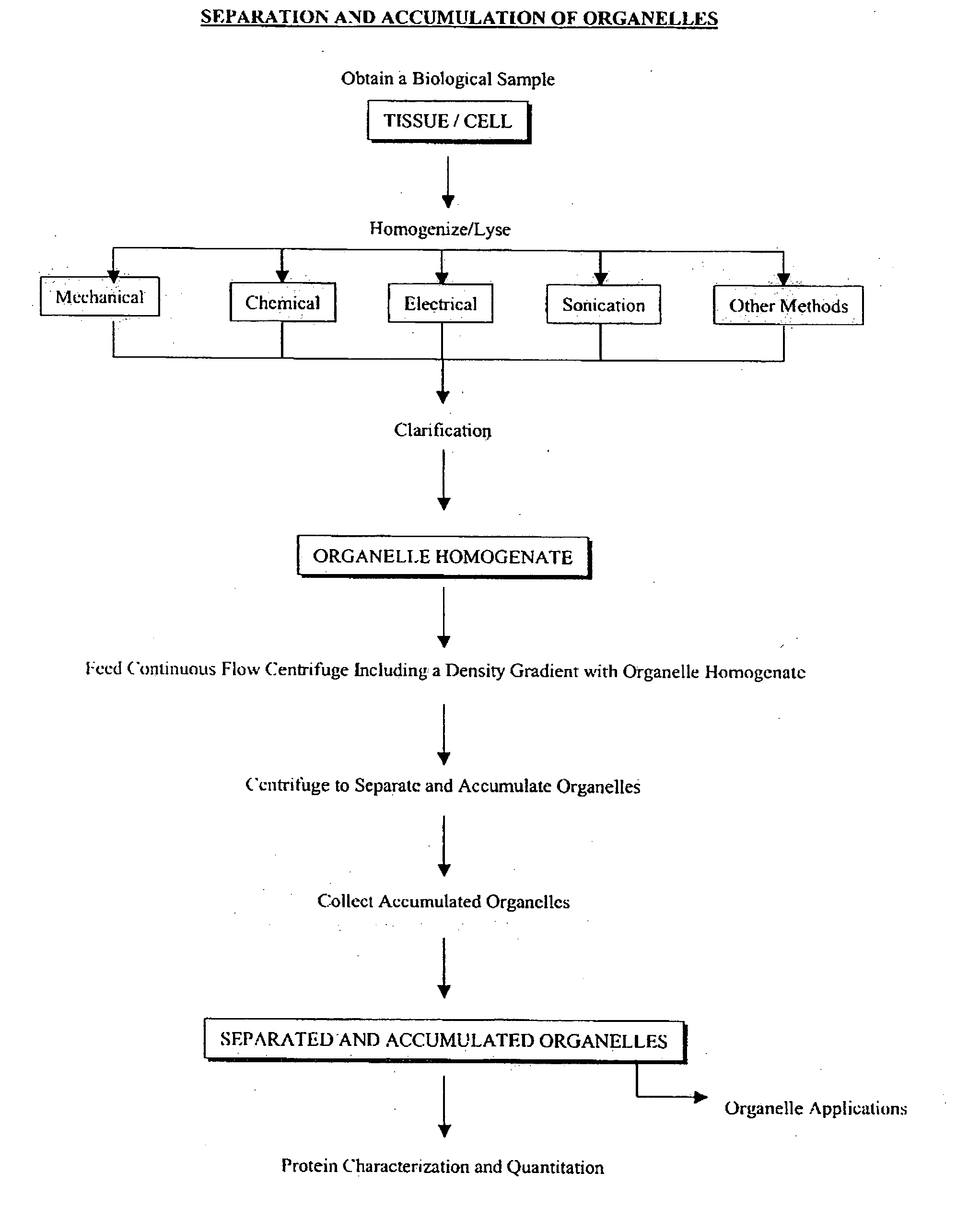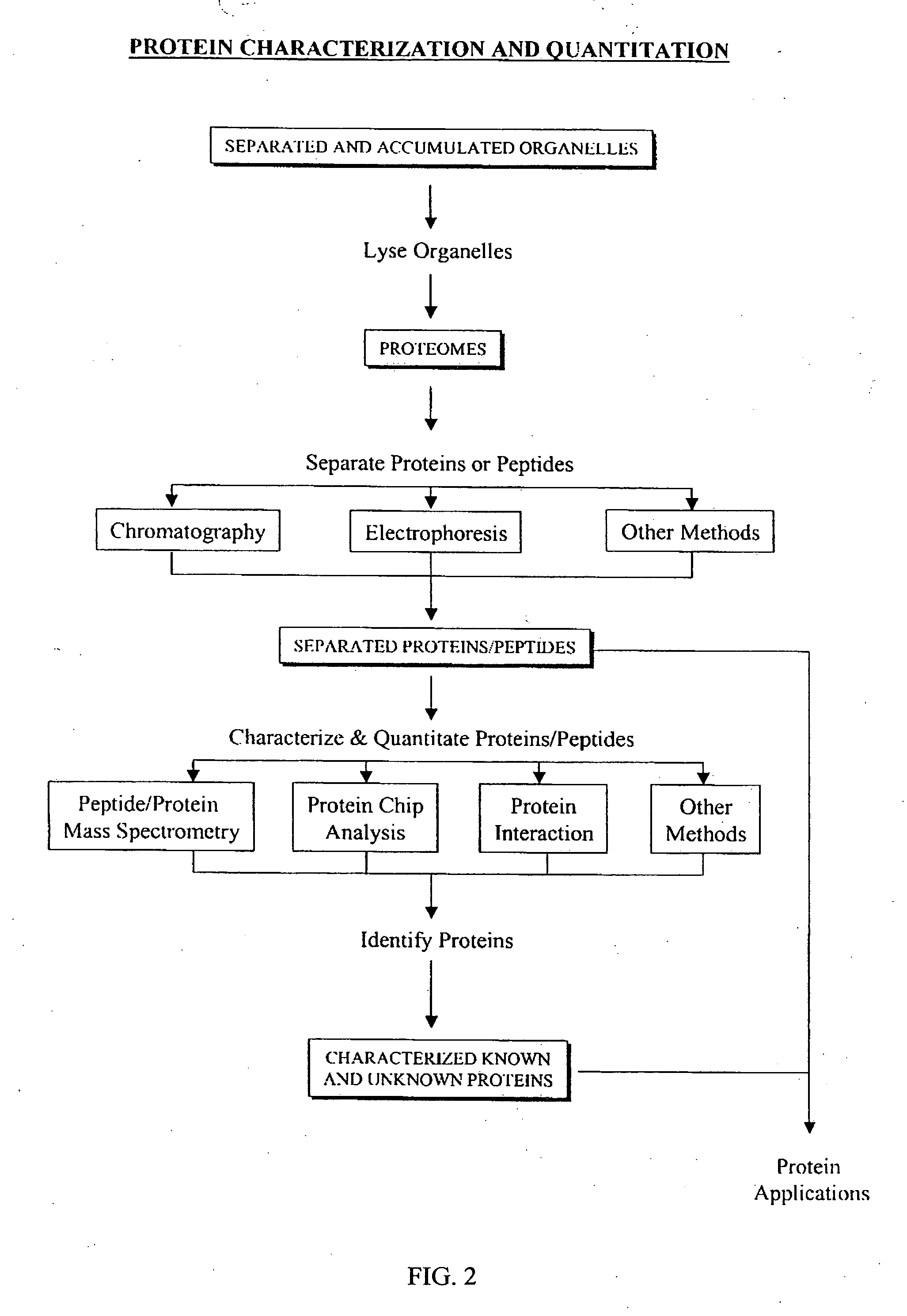Separation and accumulation of subcellular components, and proteins derived therefrom
a subcellular component and protein technology, applied in the field of proteomics, can solve the problems of not having a single strategy that can adequately address all levels of proteome organization, monitoring dynamic proteome changes at the organelle level, and a significantly higher level of complexity of proteomics, so as to achieve sufficient yield and purity, the effect of sufficient yield and purity
- Summary
- Abstract
- Description
- Claims
- Application Information
AI Technical Summary
Benefits of technology
Problems solved by technology
Method used
Image
Examples
example 1
Parallel Isolation, Purification and Enrichment of Mitochondria, Golgi, Endoplasmic Reticulum, and Plasma Membrane from Liver Tissue
[0202] Liver homogenization. Approximately 100 g of rat liver was harvested from male Wistar rats (150-200 g) that were fasted overnight prior to tissue isolation. Livers were homogenized in five volumes of homogenization buffer (0.5M sucrose, 20 mM HEPES-KOH, 5 mM MgCl2 supplemented with an EDTA-free Protease Inhibitor Cocktail from Roche) utilizing a Waring blender (10 seconds low, 10 seconds high, and 10 seconds low). Following homogenization, a post-nuclear supernatant was obtained by centrifugation at 4-5000×g for 10 minutes. Following the first post-nuclear spin, the supernatant was decanted carefully. The post-nuclear supernatant was equilibrated to isotonic conditions by addition of an equal volume of dilution buffer (20 mM HEPES-KOH, pH 7.2, 5 mM MgCl2).
[0203] Continuous-flow ultracentrifugation. For continuous flow centrifugation, sucrose gr...
example 2
Parallel Isolation, Purification and Enrichment of Mitochondria, Endoplasmic Reticulum, Golgi, and Plasma Membrane for Proteomic Analysis from HeLa Cells
[0215] HeLa cells were cultured in Joklik modified SMEM (Sigma, #61100-103) that was supplemented with sodium bicarbonate (Amresco, #0865), 10% fetal bovine serum (Paragon BioServices, #30101121) and 50 ug / ml gentamycin (Amresco, #0304). Cells were scaled up from roller bottles into a 40 L fully-controlled bioreactor for inoculation into a 200 L bioreactor. The reactor was seeded at a density of 1.0×105 cells / ml.
[0216] Three days later, cells were harvested from the reactor and concentrated by tangential flow filtration to a volume of 8 liters, which were subsequently centrifuged at 2000 rpm for 12 minutes. The cell pellet was washed and resuspended in DPBS (Invitrogen, #14190-136) and then centrifuged again at 2000 rpm for 12 minutes. The supernatant was removed and the cell pellet was stored at −80° C. in 30 g aliquots.
[0217] H...
example 3
Comparative Enrichment Studies Using HeLa Cells
[0227] Referring to the experimental conditions presented in Example 2 above, comparative enrichment was studied in accordance with the following data.
[0228]FIGS. 9 and 10 illustrate the comparative levels of enrichment achieved by the method of the invention. Enrichment can be determined qualitatively either using Western blots or enzymatic assays of organelle-specific markers and / or enzymes contrasting the signal / activity from the particular fraction of interest to the signal / activity present in another fraction or in the original crude extract of the biological sample prior to fractionation. Relative enrichment can be determined based upon the accumulation of the marker protein in the organelle fraction relative to another organelle fraction. Further, enrichment can be measured by the activity of an organelle-specific marker enzyme for an organelle of interest relative to the activity of the same marker enzyme in another fraction o...
PUM
| Property | Measurement | Unit |
|---|---|---|
| Fraction | aaaaa | aaaaa |
| Volume | aaaaa | aaaaa |
| Volume | aaaaa | aaaaa |
Abstract
Description
Claims
Application Information
 Login to View More
Login to View More - R&D
- Intellectual Property
- Life Sciences
- Materials
- Tech Scout
- Unparalleled Data Quality
- Higher Quality Content
- 60% Fewer Hallucinations
Browse by: Latest US Patents, China's latest patents, Technical Efficacy Thesaurus, Application Domain, Technology Topic, Popular Technical Reports.
© 2025 PatSnap. All rights reserved.Legal|Privacy policy|Modern Slavery Act Transparency Statement|Sitemap|About US| Contact US: help@patsnap.com



